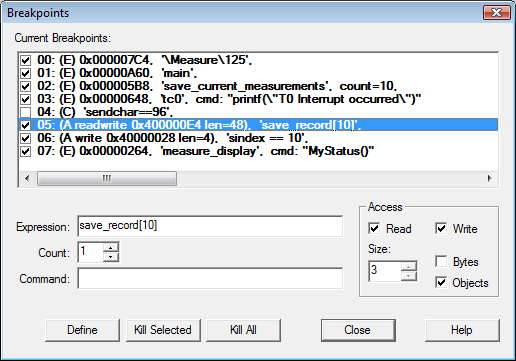|
||
| Products Download Events Support Videos | ||
Technical Support
On-Line Manuals
µVision User's Guide
Breakpoints Window
Breakpoints are program addresses or expressions that, when TRUE, halt program execution or execute a specified command. Breakpoints can be defined and modified in several ways:
![]() Using the Insert/Remove Breakpoint
toolbar button. Select the code line in the Editor or Disassembly
window and click the toolbar button or press F9.
Using the Insert/Remove Breakpoint
toolbar button. Select the code line in the Editor or Disassembly
window and click the toolbar button or press F9.
- Clicking into the left margin of the Editor or Disassembly window.
- Using the context menu of the Editor or Disassembly window.
- Using the debug commands BreakSet, BreakAccess, BreakKill, BreakList, BreakEnable, and BreakDisable.
- Using the dialog Debug - Breakpoints.

Breakpoints describes the fields. This dialog allows to:
- Define breakpoints of several types.
- Temporarily enable or disable breakpoints using the tick-box in the field Current Breakpoints.
- Review breakpoint definition by double-clicking the listed breakpoint.
- Remove one or all breakpoints.
Expressions define the breakpoint type:
- Access Break (A) gets defined when the flags Read, or Write, or both are set. The breakpoint is triggered when the specified memory access occurs. Specify the size of the memory access window in bytes or as object-size of the expression. For this breakpoint type, Expression must resolve to a memory address and memory type. The allowed operators (&, &&, <. <=. >, >=, = =, and !=) compare variable values before program execution is halted or executes the Command.
- Execution Break (E) gets defined when Expression resolves to a code address. The breakpoint triggers when the specified code address is reached. The code address must refer to the first byte of a CPU instruction.
- Conditional Break (C) is defined when Expression cannot be reduced to an address. The breakpoint triggers when the conditional expression becomes TRUE. The conditional expression is recalculated after each CPU instruction and could slow down program execution considerably.
The Count value specifies the number of times the breakpoint expression must evaluate to TRUE before the breakpoint triggers.
When a Command is specified, µVision executes the statement and then resumes program execution. The command specified in here can be a µVision debug- or signal function. To halt program execution from within such functions, set the System Variable _break_.
Note
- When an Access Breakpoint (read or write) is set to a peripheral register (SFR) in the Simulator, the breakpoint might trigger even though the application did not access the peripheral register. This happens because the µVision Simulator makes no difference between application-driven and Simulator-internal accesses.
Breakpoint Examples
Several breakpoint types defined in the picture are explaind below.
| Expression: | \Measure\125 | Execution Break (E) that halts when the target program reaches the code line 125 in the module MEASURE. |
| Expression: | main | Execution Break (E) that halts when the target program reaches the main function. |
| Expression: Count: |
save_current_measurements 10 |
Execution Break (E) that halts when the target program reaches the function save_current_measurements the 10th time. |
| Expression: Command: |
tc0 printf ("T0 Interrupt Occurred") |
Execution Break (E) that prints T0 Interrupt Occurred in the Output Window – Command page when the target program reaches the tc0 function. |
| Expression: |
sendchar == 96 | Conditional Break (C) that halts program execution when the expression sendchar == 96 becomes true. This breakpoint is disabled in the above Breakpoints dialog. |
| Expression: Access: Size: |
save_record[10] Read Write 3 Objects |
Access Break (A) that halts program execution when an read or write access occurs to save_record[10] and the following 2 objects. Since save_record is a structure with size 16 bytes this break defines an access region of 48 bytes. |
| Expression: Access: |
sindex == 10 Write |
Access Break (A) that halts program execution when the value 10 is written to the variable sindex. |
| Expression: Command: |
measure_display MyStatus () |
Execution Break (E) that executes the µVision debug function MyStatus when the target program reaches the function measure_display. The target program execution resumes after the debug function MyStatus has been executed. |
| Expression: (not in picture) |
\\cpp_template\../../source/main.cpp\268 | Execution Break (E) that halts when the target program reaches the code line 268 in the module main.cpp. The module has the relative path ../../source and belongs to the application cpp_template. |
ProductsDevelopment Tools |
Hardware & Collateral |
Downloads |
Support |
Contact |
